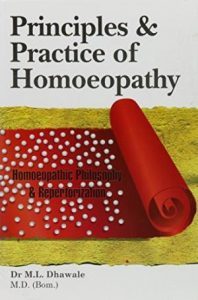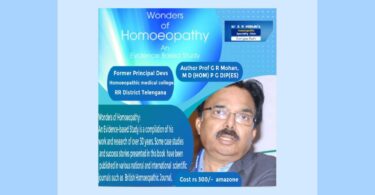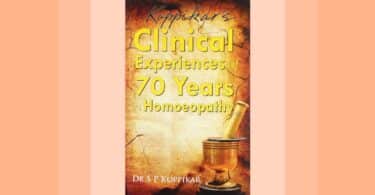Author: Dr M L Dhawale
Reviewed by: Dr Yogesh D Niturkar, MD (Hom.)
Reprinted with permission from Homeopathy360
The first edition of ‘Principles and Practice of Homoeopathy: Homoeopathic Philosophyand Repertorization’ by Dr M L Dhawale was published in 1967. In our Indian ethos, a ‘tapa’ comprises 12 years and a practitioner acquires wisdom after being committed to his work for a ‘tapa’.
This book represents the learning of the author in his first 12 years [1952-1964] of homeopathic practice most of it being under the watchful eye of his illustrious father, the late Dr L D Dhawale. Even after 47 years of its first publication, this monumental and visionary work remains relevant tothe homeopathic practice in the current medical scenario, which is a true reflection of a timeless excellence.
This masterpiece is equivalent to a course on perceiving the basic tenets of the homeopathic science and its artistic application in practice. ‘One can never claim the last word in a Course of this type. There will always be scope for further improvement.’ These words in the preface are pregnant with meaning as we have this fourth revised and enlarged edition, which is also the first international edition consisting of doctrinal and practical aspects of homeopathy along with the original works of the author not published earlier.
This book is a beacon to the serious learner of homeopathy desirous of approaching its learning in a standard and systematic way. While going through each chapter we can see the evolution of homeopathic subjects and its logical application based upon strict scientific methods.
The conceptual understanding of principles governing the practice of homeopathy has been undertaken with a remarkable precision making the reader more efficient in perceiving the individualisation of the patient, disease and the simillimum. Homeopathic doctrines and their application are illustrated through the presentation of well documented cases.
The study of homeopathic materiamedica in general and every single remedy in particular is a herculean task. This enlarged and revised international edition has minimised the technical difficulty of perceiving the homeopathic materiamedica with the section on ‘how to study homeopathic materiamedica’, illustrated with the study of the medicines Phosphorous and Mercury.
The illustrated remedial portrait is derived from various sources viz. from the study of physiological role, data from acute and chronic poisoning, study of provings, predominant sphere of action in the form of location, sensation, modalities and concomitants along with generals and particulars of the remedy and the clinical conditions. The manner in which this study is illustrated, gives us the conceptual and working knowledge of the remedy, making the learner more conversant and friendlier with
the study of homeopathic materiamedica.
Another important addition is the methodology on the study of homeopathic therapeutics that have been illustrated through the clinical conditions – disorders of cardio-vascular system (Angina Pectoris, Myocardial Ischaemia) and disorders of gastro intestinal tract (Liver affections, Haemorrhoids, Fissure of Anus and Fistula-in-Ano).
This study on homeopathic therapeutics elaborates the approach and methodology on diagnosis of disease, symptoms grouped under generals and particulars, repertorial study, remedial differentiation and ancillary measures. It covers all the aspects ofdisease and its management which makes it easy for the learner to perceive homeopathic therapeutics and apply the same logical methodology in the study of other disease conditions.
In a nutshell, this book is a classic and an exceptional work to acquire functional competence in the holistic profession which no serious learner of homeopathy can afford to ignore. B. Jain Publishers has given us access to the author’s monumental experiential learning in a masterpiece book form, which is a significant and valuable tool for the learner, the teacher and the practitioner in their service to humanity through homeopathy.
In order to have a glimpse of this precious book on Principles and Practice of Homeopathy, it can be summarised into the following parts:
- Biographical Sketch of Dr Laxman Diwakar Dhawale.
- Organon of Medicine and Homoeopathic Philosophy: Introduction to the Study of Homeopathy, Concept of Disease in Homoeopathy, Symptomatology from the Standpoint of Homoeopathic Practice, Receiving the Case, Conceptual Image in Homoeopathic Practice, Susceptibility, Homoeopathic Posology, Study of Organon, Hahnemann’s Conceptof Chronic Diseases, Management of Patients through Correspondence (Appendix A), Homoeopathic Posology, Remedy Reaction, Second Prescription (Described under Chapter 16 Homoeopathic Posology).
- Repertory: Analysis and Synthesis of the Case, Boenninghausen’s Method of Repertorization, Boenninghausen’s Therapeutic Pocket Book, Boenninghausen’s Characteristics and Repertory (Boger), Kent’s Method of Repertorization, Card Method of Repertorization (Boger): With Illustration of Cases
- Homoeopathic Materia Medica and Therapeutics: Perceiving Theory, its Application and Management in Homeopathic Practice (including Follow Up of Patient). This section covers:
- Remedy Selection in Homoeopathic Practice
- Homoeopathic Materia Medica
- How to study Homeopathic Materia Medica- An Illustrative Approach (Appendix C)*
- Homeopathic Therapeutics (Appendix D)* : Angina Pectoris, Myocardial Ischaemia (Infarction, Liver affections, Haemorrhoids, Fissure of Anus and Fistula-In-Ano
- Academic: Appendix B covers various aspects of Post Graduate Teaching of Homeopathic Philosophy and Repertorization, Homeopathic Materia Medica and the Metamorphosis of a Physician.
- The Research part has been covered under the sections:
- The Scientific Basis of Homoeopathy
- Place of Homoeopathy in Medicine
- Recommended Reading Material: Reading Resources gives information about the Introductory Books, Text Books, Source Books, Additional Reading, Concept of Disease, Knowing the Patient, Case Taking, Repertorization,Repertories, Logic and Scientific Method, Hahnemann- Biography, Periodicals, References to Old Periodicals.
*New additions in the book: – Appendix C and D







salam im dr.ali reza fathi md homeopath from iran .I need book about manur repertory and analysis boger bougsenhigsen kent vithoulkas.because in iran not being.
How much would a first edition of this book cost?